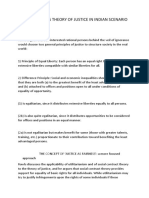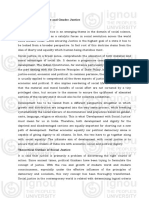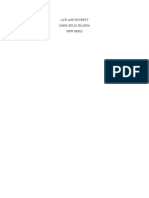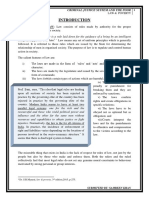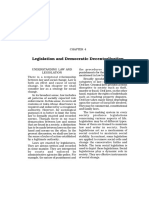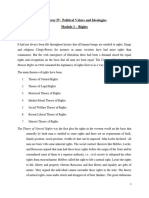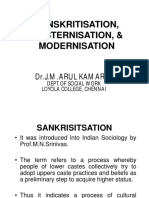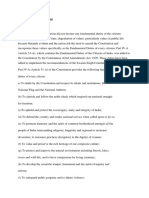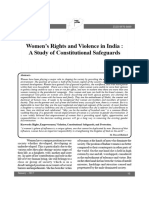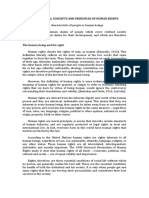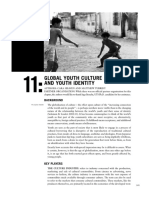THE FIRST ANNUAL DR. K.R.
NARAYANAN
MEMORIAL LECTURE
AT JAMIA MILLIA ISLAMIA UNIVERSITY
NOVEMBER 13, 2007
THEME: PROBLEMS OF SOCIAL INEQUALITY AND POSSIBILITIES OF
JUDICIAL INTERVENTION
I am indeed happy and feel privileged to give the First Annual
Memorial Lecture named after Dr. K.R. Narayanan, at the instance of
Jamia Millia Islamia University. This University is a prestigious institute.
This institute, which was originally started at Aligarh in United Provinces in
1920, became a centre of education. In 1928 Dr. Zakir Husain became the
Vice-Chancellor of the University and his contribution to this University was
phenomenal. So many eminent personalities have been associated with
this University. Father of our nation Gandhiji wanted to see this institute to
1
�become a great centre of learning. This University had survived the turmoil
that prevailed in the pre-independent India.
Dr. Kocheril Raman Narayanan was born in a poor family in a village
Uzhavoor in Kottayam district in the State of Kerala. He was a very bright
student and passed out successfully his matriculation. He joined the CMS
College Kottayam for his graduation. A freedom fighter and social activist
helped him to pursue his studies. Later, with the help of TATA institute he
continued his studies in London School of Economics and obtained his
B.Sc. (Econ.) degree. When he returned from London, his future was a
baffling one and his teacher Harold Laski of the London School of
Economics gave him a letter of introduction to Pandit Jawahar Lal Nehru,
who was also a former student of Harold Laski. Dr. K.R. Narayanan made
repeated attempts to meet Panditji who was then the Prime Minister of
India. Lastly, he got an opportunity to meet him in the Parliament House.
He had a brief interview with Panditji. At the end, he gave the letter of
Harold Laski to Panditji and quickly walked out of the room. While he was
moving through the corridors of Parliament House, he saw Panditji
beckoning him to come back and asked “Why did not you give this letter to
me earlier?” He replied, “I am sorry. I thought it would be enough if I just
handed it over while leaving.” Panditji asked him to join the Indian Foreign
2
�Service. Then started the bright career of Dr. K.R. Narayanan as a
member of Indian Foreign Service. He worked as an Ambassador in
various countries and retired from Indian Foreign Service in 1978. Later,
he became the Vice-Chancellor of the Jawahar Lal Nehru University. He
held various positions with utmost satisfaction. He was a scholar of
eminence, great leader and prolific writer. As an Advocate, I had the
opportunity to meet him frequently. Once he told that when the Chinese
Government celebrated the 50th year of Panchsheel various world leaders
were invited to Beijing and there he was treated as the most important
person who attended the conference – the conference in which world
leaders were present. His commitment to social justice and principles of
the equality and rule of law was known to all. I congratulate the Jamia
Millia Islamia University for having thought it fit to have a memorial lecture
in the name of Dr. K.R. Narayanan.
The Indian Constitution embraces the goal of achieving social equality
in express terms. The constitutional scholar Granville Austin, in his
magisterial work, “Working a Democratic Constitution: the Indian
Experience”, states that probably no other Constitution in the world “has
3
�provided so much impetus towards changing and rebuilding society for the
common good”.
Indeed, it is perhaps one of the most rights-based constitutions in the
world. Interestingly, around the same time, the Universal Declaration of
Human Rights (UDHR) also saw the light of day, in 1948. Article 1 of the
UDHR has become central to the functioning of the United Nations, and
recognizes that equality is the core value that lies at the very root of human
dignity. The reality of inequality, and its possible solution, is manifest in the
Preamble, followed by the Fundamental Rights and Directive Principles.
The Preamble makes explicit, the resolve to create a “socialist and
democratic republic” in order to secure political justice, equality, liberty and
dignity. Many of the principles espoused can also be found in the UDHR.
The principle assertion being that in order to obliterate social injustice,
upholding the dignity of the human personality is paramount. The Indian
Constitution, as a social document, seeks to foster this by striving to create
the requisite social, cultural, political and economic conditions that are
required to attain this noble goal. Its ideals are based on the grim
experience of colonialism, and India’s bitter struggle against that imperial
regime, which consistently violated the rights of the people of India, and
4
�worked relentlessly to create inequalities within the social strata. There was
intense and extensive social and economic discrimination due to irrational
prejudices, which resulted in certain sections of society to suffer severe
handicaps in practically all walks of life. However, it is also true that the
British brought with them certain reforms that were largely influenced by
Western thought. Notable among these, were the abolition of slavery in
1843, abolition of the practice of Sati in 1829 and prevention of female
infanticide. However, despite these measures, the problems of social
inequality were deep rooted in India, and at that time, possibilities of judicial
intervention were limited.
After the adoption of our Constitution, large scale social and
economic changes have taken place. It is true that in many areas, we
could not achieve the desired results, but even then the powers of law and
legislation have tremendous impact in society. Law is essentially marginal
to the process by which society changes; law is an effect rather than a
cause. It is only within the limits given there that change can be
accomplished. Legislation is always based on the quintessence of the
public opinion. But inevitably, it often lags behind the real life and Goethe
once said of law as the rule of dead over the living. This is too a
5
�conservative view and sees law as passive and reactive, something that
accommodates change rather than causes it.
India after attaining independence by a series of social welfare
legislations based on the mandate of our Constitution proved that law could
be active and dynamic. No longer was the State seen as standing to one
side of the society and performing the role of a night watchman, but as a
manager of social and economic interests. The State has become the
centre of political and economic power and source and distributor of basic
legal rights and material standards. The operation of law with numerous
regulations brings about change in the society.
Society is constantly in motion, economies strengthen and fail,
technology moves on, new social institutions emerge, even there is
fundamental alteration of the structure of the society. We cannot point out
any single legislation or judicial decision which has changed society or its
relationship between members just as in America by single stroke of pen
Abraham Lincoln freed the slaves of America.
6
� Law and legal system have impact on the changes either originating
from within or from outside. But these social changes are easier if the
commitment to an activity is not high as here the law can tip the balance in
favour of other behaviour. Sometimes it is difficult and uncertain process.
See for example, the tribal laws made for restoration of their lands from the
persons who are in illegal occupation. Many members of the tribal
community owned lands and their lands were usurped by cheating them
and law was enacted to restore those lands. It was partly implemented in
the sense that they filed applications for restoration and the Revenue
Divisional Authorities passed orders for restoration of these lands. But the
execution of these orders was resisted by the trespassers who formed a
powerful section of community. The law had ultimately to be abandoned
and new law was enacted just to appease the Tribals with mirage that they
would be given lands freely; a promise which cannot be fulfilled for various
reasons.
Any goal of law, must be realisable through law, that is, the change
required must be capable of being communicated to the bulk of the people
and must have a compatibility with the existing values. It is probably
7
�difficult to stop people from doing what they have always thought right. The
required change should be capable of being implemented.
Law has wide variety of powers to enforce law, much more than the
sanction under criminal law. Freund has categorized manifestations of
government power to realise law; the police force, taxation system, the
ability to manage public property and resources. For example, the pollution
from exhaust emissions for motor vehicle could be checked not only
prohibiting or modifying it, but by widening the categories of tortuous
liability to allow claims to those who are affected by setting standards in
manufacture or by negative financial incentive1.
There are also wide varieties of implementative techniques to
translate a legislative aim into a social behaviour. Law does not work only
by straightforward command; it defines, gives status and rights and
selectively distribute burdens and incentives. It sets up facilities and
standards, creates disabilities and operates in private sphere to arrange
things; it sets up agencies to operate the system. Law thus has
spectacular effect to bring about social change. But the change through
8
�law is difficult to plan, complex to execute and often uncertain in its
consequences.
Justice is often understood, in a narrow sense, to mean justice
according to law or justice of law. But, nowadays, the word “justice” is
used in a wider sense and includes its different forms like social, economic
and political justice. The concepts of social justice are varied, but equality
is integral to most contemporary theories of justice. The urge for social
justice gathered momentum when India became an independent
sovereign republic. The concept of social justice deals with all aspects of
human life. Harold J. Lasky remarked “that the more equal are the
social rights of citizens, the more likely they are to be able to utilize
their freedom in realms worthy of exploration.” The purpose of social
justice is to maintain or to restore equilibrium in the society and it envisages
equal treatment of equal persons in equal or essentially equal
circumstances. The social solidarity is brought about by the concept of
social justice.
The framers of our Constitution then toiled hard to inject equality,
justice and good conscience at the heart of the social system, since any
9
�thought of social betterment of the nation would be a teasing illusion if the
requisite social conditions based on social equality did not exist.
In the Constituent Assembly, on 25th November, 1949, Dr. Ambedkar
stated:
“On the 26th January, 1950, we are going to enter upon into a life of
contradictions. In politics we will have equality and in social and economic
life we will have inequality. In politics we will be recognizing the principle of
one man one vote and one vote one value. In our social and economic life,
we shall by reason of our social and economic structure, continue to deny
the principle of one man one value. How long shall we continue to deny
equality in our social and economic life? If we continue to deny it for long,
we will do so only by putting our political democracy in peril. We must
remove this contradiction at the earliest possible moment else those who
suffer from inequality will blow up the structure of democracy which this
Constituent Assembly has so laboriously built up.”
Thus, realizing that the masses had suffered for long, and recognizing
the reality of prevailing social inequalities, the founding fathers placed the
10
�mandate of social equality at the helm of the Constitution, and attempted to
create a system where every member is empowered to participate in the
liberties and the freedom provided under the Constitution.
Pandit Nehru embodied the essence of this goal in the following words
to the Constituent Assembly:
“The first task of this Assembly is to free India through a new
Constitution, to feed the starving people and to clothe the naked masses
and to give every Indian the fullest opportunity to develop himself
according to his capacity”.
With this noble aim, the founding fathers inserted the Fundamental
Rights and Directive Principles in the Constitution, which find their roots in
the Constitution of India Bill, 1895 and the 1931 Karachi Resolution
respectively. They form the soul of this living document, and connect
India’s past, present and future into one single thread, giving greater
credence to the pursuit of social equality.
11
� In the words of Justice Learned Hand, of the United States’ Supreme
Court:
“… such constitutional limitations arise from grievances, real or
fancied, which their makers have suffered and…they withstand the winds
of logic by the depth and toughness of their roots in the past.”
In his Article titled “Challenge to the Living Constitution” by Herman
Belz, the author says that the Constitution embodies aspiration to social
justice, brotherhood and human dignity. It is a text which contains
fundamental principles.
In M. Nagraj v. Union of India (2006) 8 SCC 212, the Supreme Court
explained the concept of social justice as flowing out of the Fundamental
Rights in the following words:
“…Social justice is one of the sub-divisions of the concept of justice. It
is concerned with the distribution of benefits and burdens throughout a
society as it results from social institutions - property systems, public
organisations etc. The problem is - what should be the basis of
12
�distribution? Writers like Raphael, Mill and Hume define ‘social justice’ in
terms of rights. Other writers like Hayek and Spencer define ‘social justice’
in terms of deserts. Socialist writers define ‘social justice’ in terms of need.
Therefore, there are three criteria to judge the basis of distribution, namely,
rights, deserts or need. These three criteria can be put under two concepts
of equality - “formal equality” and “proportional equality”. “Formal equality”
means that law treats everyone equal and does not favour anyone either
because he belongs to the advantaged section of the society or to the
disadvantaged section of the society. Concept of “proportional equality”
expects the States to take affirmative action in favour of disadvantaged
sections of the society within the framework of liberal democracy. Under
the Indian Constitution, while basic liberties are guaranteed and individual
initiative is encouraged, the State has got the role of ensuring that no class
prospers at the cost of other class and no person suffers because of
drawbacks which is not his but social… Therefore, axioms like secularism,
democracy, reasonableness, social justice etc. are overarching principles
which provide linking factor for principle of fundamental rights like Articles
14, 19 and 21.”
13
� Thus, the Fundamental Rights, through Articles 14, 15, 16 and 17
reflect the right to equality in its various aspects and aim to foster social
equality by empowering the citizens to be free from any form of coercion or
restriction by the state or private people. The Directive Principles aim at
creating an egalitarian society whose citizens are free from the abject
physical conditions that had hitherto prevented them from fulfilling their best
selves. They are the creative part of the Constitution, and fundamental to
the governance of the country. It is interesting to note that at the time of
drafting of the Constitution, some of the Directive Principles were part of
the declaration of fundamental rights adopted by the Congress party at
Karachi. Mr. Munshi had even included in his draft list of rights, the “rights
of workers” and “social rights”, which included provisions protecting women
and children and guaranteeing the right to work, a decent wage, and a
decent standard of living. The primordial importance of Part IV can be
understood by the following words of Dr. Ambedkar, when he insisted on
the use of the word “strive” in Article 38:
“We have used it because it is our intention that even when there are
circumstances which prevent the Government, or which stand in the way
of the Government giving effect to these directive principles, they shall,
14
� even under hard and unpropitious circumstances, always strive in the
fulfillment of these directives. … Otherwise it would be open for any
Government to say that the circumstances are so bad, that the finances
are so inadequate that we cannot even make an effort in the direction in
which the Constitution asks us to go.”
Thus, the enforceability of measures relating to social equality was
never envisaged as being dependent only on the availability of state
resources. Going further, though the Fundamental Rights and Directive
Principles may resemble Western constitutional provisions, they can be
distinguished in their innate desire to end the inequities of traditional social
relations and enhance the social welfare of the population. Other provisions
furthering social equality include Article 334, and those relating to the
upliftment of Anglo Indians. Again, Article 23 prohibits the trafficking of
human beings and other forms of forced labour and Article 24 protects
children under the age of fourteen from enduring the hazards of
employment in difficult conditions. Freedom of Religion, freedom of
conscience and free profession, practice and propagation of religion;
freedom to manage one’s religious affairs; and freedom to attend religious
instruction or religious worship in certain educational institutions has been
15
�ensured through Articles 25, 26, 27 and 28 of the Constitution. Articles 29
and 30 deal exclusively with the Cultural and Educational Rights of
Minorities while ensuring equal opportunity for all citizens to take admission
in any educational institution.
The Courts have taken recourse to these provisions often, in their
crusade to bring justice to the poor. Through innovative and creative
strategies, they have expanded the scope of the Fundamental Rights, in
order to render justice to women, children, bonded laborers and other
oppressed sections of society. The Courts have also played a significant
role in bridging the divide between the colonial legal system and the value
based jurisprudence of our Constitution. Notably, over the decades, the
Supreme Court has affirmed that both the fundamental rights and Directive
Principles must be interpreted harmoniously. It was held, in Kesavananda
Bharati v. State of Kerala, (1973) 4 SCC 225, that the directive principles
and the fundamental rights supplement each other and aim at the same
goal of about a social revolution and the establishment of a welfare State,
also envisaged in the Preamble. Furthermore, in Unni Krishnan, J.P. v.
State of A.P., (1993) 1 SCC 645, Justice Jeevan Reddy declared, at p. 730,
para 165, that:
16
� “The provisions of Parts III and IV are supplementary and
complementary to each other and not exclusionary of each other and that
the fundamental rights are but a means to achieve the goal indicated in
Part IV”.
This would go a long way to help create the necessary social
conditions that would ultimately result in social equality.
The Right to Education
The theory of the complementarities of rights and their harmonious
nature has laid the foundation for the realization of primary education being
declared a fundamental right, through two judgments of the Supreme
Court.
The use of education as tool for achieving socio-political justice was
largely ignored until the judgment in Mohini Jain v. State of Karnataka
(1992) 3 SCC 666. The Court held that:
17
� “the right to education flows directly from the right to life” as “the right
to life and the dignity of an individual cannot be assured unless it is
accompanied by the right to education”, and “the fundamental rights
guaranteed under Part III of the Constitution of India, including the right to
freedom of speech and expression and other rights under Article 19 cannot
be appreciated and fully enjoyed unless a citizen is educated and is
conscious of his individualistic dignity”.
The Supreme Court also referred to the UDHR principles and to Article
41 of the Constitution. Later, in Unni Krishnan, the Court took support from
UDHR and Article 13 of the International Covenant for Economic, Social
and Cultural Rights and for the first time articulated education as a “social”
right.
The Right to Health
Article 47 declares that the “State shall regard the raising of the level
of nutrition and the standard of living of its people and the improvement of
public health as among its primary duties”. The right to health also has its
reference in Articles 38 (social order to promote the welfare of the people),
18
�39(e) (health of workers, men, women and children must be protected
against abuse), 41 (right to public assistance in certain cases, including
sickness and disability) and 48A (the State’s duty to protect the
environment) of the directive principles. The right to health has also been
articulated as an integral part of the right to life. In Consumer Education
and Research Centre v. Union of India (1995) 3 SCC 42, the Supreme
Court dealt with the health hazards faced by workers engaged in the
asbestos industry. Reading concurrently Article 21 with Articles 39(e), 41
and 43, the Supreme Court held that
“the right to health ... is an integral facet of a meaningful right to life”
(para 24).
The Supreme Court and Article 21
The Right to Life enshrined in Article 21 has also been interpreted to
include the right to be free from degrading and inhuman treatment, the right
to integrity and dignity of the person, and the right to speedy justice.
19
� In the words of Justice Bhagwati, in Francis Coralie vs. Union Territory
of Delhi (1981) 1 SCC 688:
“we think that the right to life includes the right to live with human
dignity and all that goes along with it, namely the bare necessities of life
such as adequate nutrition, clothing and shelter over the head and facilities
for reading, writing and expressing oneself in diverse forms.”
In Maneka Gandhi v. Union of India (AIR 1978 SC 597), it was stated
by the Supreme Court that equality is a dynamic concept with many
aspects and dimensions and it cannot be imprisoned with traditional and
doctrinaire limits. Thus, it is the Courts that have given these Rights and
Principles their real meaning. They have adopted substantive equality, and
aimed for a result oriented approach. This approach tends to encourage
the downtrodden and underprivileged to redeem themselves of previous
inequalities, and has resulted in greater judicial activism, and has opened
new vistas for judicial innovation and creativity, in order to fulfill the
mandate of achieving social equality. Commenting on judicial activism, the
scholar S.P. Sathe, in his work, “Judicial Activism in India”, opines that the
20
�judicial process has changed from an adversarial, bilateral process to a
polycentric, conflict-resolving process.
Enforcement of social rights through judicial intervention can also be
seen in other countries such as Argentina, Brazil, Colombia, Finland, Latvia
and South Africa, as well as almost all regional and international human
rights courts and quasi-judicial committees. In Social and Economic Rights
Action Centre (SERAC) v. Nigeria, the African Commission on Human
Rights drew on the UN Committee on Economic, Social and Cultural
Rights’s General Comment No. 4 on the Right to Housing to condemn
forced eviction of the Ogoni people in Nigeria, while in Plan de Sánchez v.
Guatemala, the Inter-American Commission on Human Rights quoted the
same General Comment as it ordered Guatemala to implement an
adequate housing program as part of a remedial package for survivors of a
1982 massacre.
Therefore, timely judicial intervention has made social rights
adjudication in India vibrant and dynamic, leading to the enforceability of
rights such as the right to food, the right to education, and the right to
21
�health, even though they have not been included a express fundamental
rights in the Constitution.
Bonded Labor
Bonded labor in all its forms, of children or adults, expressly violates
the Bonded Labour System (Abolition) Act, 1976 and in the case of
children, the Children (Pledging of Labour) Act, 1933, as well as certain
constitutional provisions, namely, Article 23 (1), Article 24 and Article 39.
The former prohibits the creation of bonded labor agreements and contains
penal offences against people engaging in attempts to engage in bonded
labour, and the latter penalizes any parent, middleman, or employer
engaged in making or executing a pledge of a child’s labor.
However, the implementation of these legislations was often callous,
requiring the intervention of the Supreme Court to deal with this serious
issue, which was fast emerging as a pressing concern. Thus, in People’s
Union for Democratic Rights v. Union of India [Asiad Workers’ Case], AIR
1982 S.C. 1473, the Supreme Court defined the ambit of “forced labour”.
According to the Court, “forced labour”, includes any situation “where a
22
�person provides labour or service to another for remuneration which is less
than minimum wage . . .”
Supsequently, in Bandhua Mukti Morcha v. Union of India, (1984) 3
SCC 161, the Supreme Court embarked on the process of identifying,
releasing and rehabilitating bonded labourers, ensuring minimum-wage
payments and availability of wholesome drinking water and setting up dust-
sucking machines in the stone quarries. These orders of the Court were
monitored through a monitoring agency, which would check the
implementation of those directions.
These interpretations by the Supreme Court were powerful steps
towards the realization of a social order based on equity.
Rights of Indigenous People
The Indian Judiciary has been at the forefront of protecting the rights of
tribal communities, in order to promote social justice. In Samantha v. State
of A.P. (1997) 8 SCC 191, the Supreme Court observed that:
23
�“Agriculture is the only source of livelihood for scheduled tribes, apart from
collection and sale of minor forest produce to supplement their income.
Land is their most important natural and valuable asset and imperishable
endowment from which the tribals derive their sustenance social status,
economic and social equality and permanent place of abode and work and
living. It is a security and source of economic empowerment. Therefore,
the tribes too have great emotional attachment of their lands. The land, on
which they live and till, assures them equality of status and dignity of
person and means to economic and social justice and is a potent weapon
of economic empowerment in a social democracy.”
Thus, with this, the Court opened another vista for judicial intervention, and
ensured that even the forest communities enjoy the rights and protections
guaranteed to them under our Constitution, such that slowly but surely, we
would achieve the sagacious ideal of social equality.
Gender Justice
Instances of sexual harassment at the workplace were on the rise, and
were often seen as a tool to deny women equal opportunity at work. The
24
�judgment of the Supreme Court in the Vishaka Case [Vishaka v. State of
Rajasthan (1997 6 SCC 241)] ushered in judicial activism in the area of
gender justice, thereby ensuring social equality at the workplace. The
Court, assisted by international conventions and norms which encapsulate
these rights, such as the Convention on the Elimination of All Forms of
Discrimination Against Women (CEDAW), stated that:
“Sexual harassment of women in the workplace results in the violation of
the fundamental rights of gender equality and the right to life and liberty; It
is a clear violation of the rights under Articles 14, 15, 21…and 19(1)(g)…
and; Gender equality includes protection from sexual harassment and the
right to work with dignity, which is a universally recognized basic human
right.” It was also observed that, “the absence of enacted law to provide for
the effective enforcement of the basic human right of gender equality and
guarantee against sexual harassment…particularly at workplaces…”
Thus, the judgment recognized that in the absence of legislation dealing
with such situations, it was imperative for the judicial process to intervene
and facilitate the process.
25
�Land Reform
In the area of land reform, the Supreme Court has championed the cause
of promoting social equality that the British had zealously kept away,
fearing that any such social change would pose as a threat to their rule.
One of the earliest examples are the cases of Shankari Prasad v. Union of
India [AIR 1951 SC 458], in 1951, and the Kameshwar Singh case [AIR
1952 SC 252] of 1952, where the federal vestiges of the British rule were
finally removed from the social stratum, and land reform measures were
upheld by the courts, since they furthered the goal of a social order that
found foundation in social equality. The courts were well aware of the
issues of social inequality and made constructive efforts to promote
equality in means of livelihood and in equal ownership and control of
material resources of the community, such that they are disbursed to serve
the common good. These early decisions reflect a progressive attitude that
greatly contributed to social change and promotion of social equality and
justice, as enshrined in Article 38 of the Constitution. The Courts ensured
that the Indian judiciary never stood in the way of the implementation of
both radical and welfare measures by the Legislature and Executive.
26
�Rather, it has ensured that a number of social legislations made for the
benefit of the poor and downtrodden are implemented in the proper spirit.
I would like to conclude with the following words, by Dorothy Day, an
American social activist, who espoused the cause of the impoverished and
underprivileged:
“What we would like to do is change the world- And, by fighting for better
conditions, by crying out unceasingly for the rights of the workers, of the
poor, of the destitute…we can, to a certain extent, change the world; we
can work for the oasis, the little cell of joy and peace in a harried world. We
can throw our pebble in the pond and be confident that its ever widening
circle will reach around the world.”
27




















